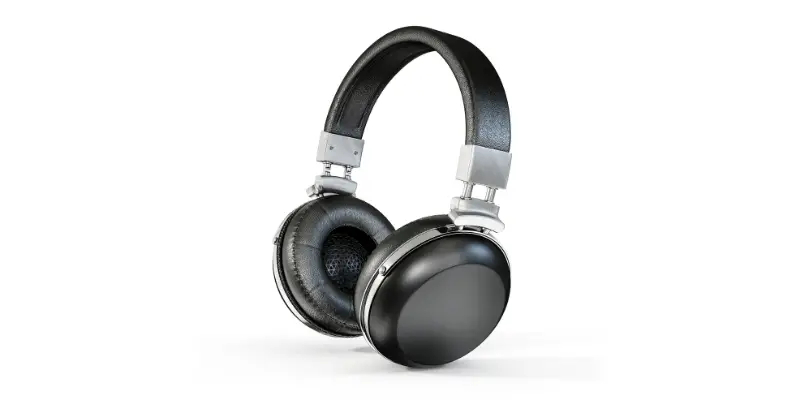Disclaimer: This post may contain affiliate links, meaning we get a small commission if you make a purchase through our links, at no cost to you. For more information, please visit our Disclaimer Page.
With the recent rise in popularity of high-quality headphones, they’ve become more and more expensive. The question many musicians, audiophiles, and consumers ask is, “Can too much bass damage my headphones?”
Excessive bass played at a high-volume level can damage your headphones. This is because the headphone drivers have to work harder to reproduce the increased amount of bass-heavy sound, making them more vulnerable to breaking. As long as you do not exceed the headphone’s limit, it will not break.
Table of Contents
Can Too Much Bass Damage Ears?
Bass-heavy music can damage your ears if the overall volume level is dangerously high. This damage can be temporary, similar to the feeling you get right after you leave a concert. Or it can be permanent if you expose yourself to loud music regularly.
How Our Hearing Works
Before we explore the relation between bass and our ears, let’s see exactly how our hearing mechanism works.
Inside our ear, we have tiny hairs that vibrate due to incoming sound waves and convert these vibrations into nerve signals. These signals then go to the brain and we perceive the waves as audible sounds.
Now, each hair responds to sounds of specific frequencies. The hairs at the beginning translate low-frequency sound into signals. The hairs at the backend translate high-frequency sounds.
How Bass Can Damage Our Ears
When it comes to hearing loss due to sound, the volume level of the sound plays a larger role than the frequency. To put it simply, volume is the amount of force the sound hits your eardrums with. And frequency is the number of times those sound waves are hitting your eardrums.
So, a high-frequency or high-pitched sound enters your ear canal in rapid succession compared to a low-pitched sound. This is why you are more likely to develop hearing loss if the sound is of a higher pitch and also why shrieking, sharp noises are so irritating.
Bass is a range of frequency that is on the low side of the auditory scale. Typically, any sound between 60 to 250 Heartz falls in the domain of bass. Anything below is what we call sub-bass.
As you can see, as far as dangerous sound frequency goes, the bass is quite harmless. It is only when the bass is coupled with excessive volume levels then it becomes a problem.
Louder sound puts more pressure on the hairs inside our ears. This, in turn, damages the hair cells or makes them go flat. If the hair is lying flat and does not move, it will not create vibrate. Thus, it will not generate nerve impulses and we will not be able to hear.
Now, if the loud music was particularly bass-heavy, then the hairs responsible for low-frequency sounds will be more vulnerable. And if these hairs lose their functionality, you will be unable to hear sounds that are deep or low-pitched.
This damage to your hearing can be of two types. If you ever stand next to a loudspeaker or come out of a concert, you will experience difficulty in hearing. But after a while, the sound will return and you can hear everything just like normal. This is a temporary hearing loss called a temporary threshold shift.
But if your hearing does not return to normal after some time, the damage is most likely permanent. Typically, this occurs when you repeatedly expose yourself to high levels of noise without any sort of protection.
So, if you hear bass-heavy music at dangerously high volumes for too long, you have a great chance of developing hearing problems.
Can Too Much Bass Damage Headphones?
Too much bass in conjunction with loud noise levels can damage your headphones or cause a decline in performance.
How Headphones Work
Once again, we will look at how a thing works before explaining how you can break it. If you break open the earpiece of a headphone (wired, wireless, in-ears, over-ears) you will find the headphone driver or driver unit. This is the part that converts the electrical signal into audible sound waves.
This has 3 major parts – a magnet, a voice coil, and a diaphragm. Depending on the manufacturer, there can be other components and they will look slightly different. But these three are the key players.
The magnet creates a magnetic field. The voice coil is a coil of metal (typically copper) that moves within the magnetic field. And the diaphragm is a plastic or paper membrane that moves along with the coil and pushes out air.
The audio first comes to the driver as an electrical signal or current. When the current travels through the coil, it oscillates back and forth. Then the diaphragm will also oscillate or vibrate which pushes the air in front of it periodically. Thus, the headphones reproduce the audio waves from the electrical signal.
The volume level and frequency of the sound will determine the rate and depth of the driver’s movement. If it is very loud music, the driver will oscillate with greater force. And if the sound is high-pitched, the driver will move at a faster rate.
How Bass Can Damage Headphones
As we already mentioned, the bass has a very low frequency of 60-250 Hz. Our hearing is limited in the range of 20 to 20,000 Hz. Since bass is on the very low end of this human auditory scale, we will find it harder to hear the bass. If you listen to a song, the bass component will get drowned by the other instruments and sounds.
So, the headphone drivers have to work extra to amplify the bass noise into more audible levels. This requires more power and more air displacement This is how headphones and speakers are able to produce bass music that manages to stand out even in high-pitched songs.
The problem is that the more you work with the driver, the more vulnerable it becomes. And if the driver is extended beyond its limit, it will break. This point is called the excursion limit and every audio device has its own. When you push any headphones to this point, the sound will become distorted.
Now, modern headphones are quite adept at producing bass at an audible level without breaking down quickly. In fact, you are likely to damage your ears long before you generate the level of bass needed to damage the actual headphones.
So, the bass frequency alone will not ruin your headphones. But playing high bass at greater volume means the drivers will work harder to make the bass audible. And doing this repeatedly may cause deterioration in the driver and limit its capabilities.
This is more common in cheap, low-grade headphones that cannot handle the heavy bass. So, they eventually give out. So, if you are someone who appreciates heavy bass but does not want ear damage, you should get headphones accordingly.
Can Too Much Bass Damage Speakers?
Speakers work basically like a headphone but on a much larger scale. Instead of a flat diaphragm, you have a large, conical paper that oscillates to push the air. The louder the sound level, the harder this cone will move.
This can cause the cones to deform permanently. When this happens, the speaker fails to reproduce audio as efficiently as it once did.
There are speakers capable of producing bass at a high volume called woofers. Manufacturers design these devices to generate high-bass levels for sustained periods without deteriorating. For people who love really loud bass, these speakers are the ideal choice.
But midrange speakers are not meant to reproduce low frequencies as well as the woofers. So, forcing them to do just that will ultimately compromise its performance.
Conclusion
Bass is an important part of enjoying any musical performance. So, if you want to experience it in full, you should get headphones or speakers that are designed for this task. But always remember to keep the overall volume levels low.
References:
https://nasdonline.org/1091/d000882/noise-the-invisible-hazard.html


